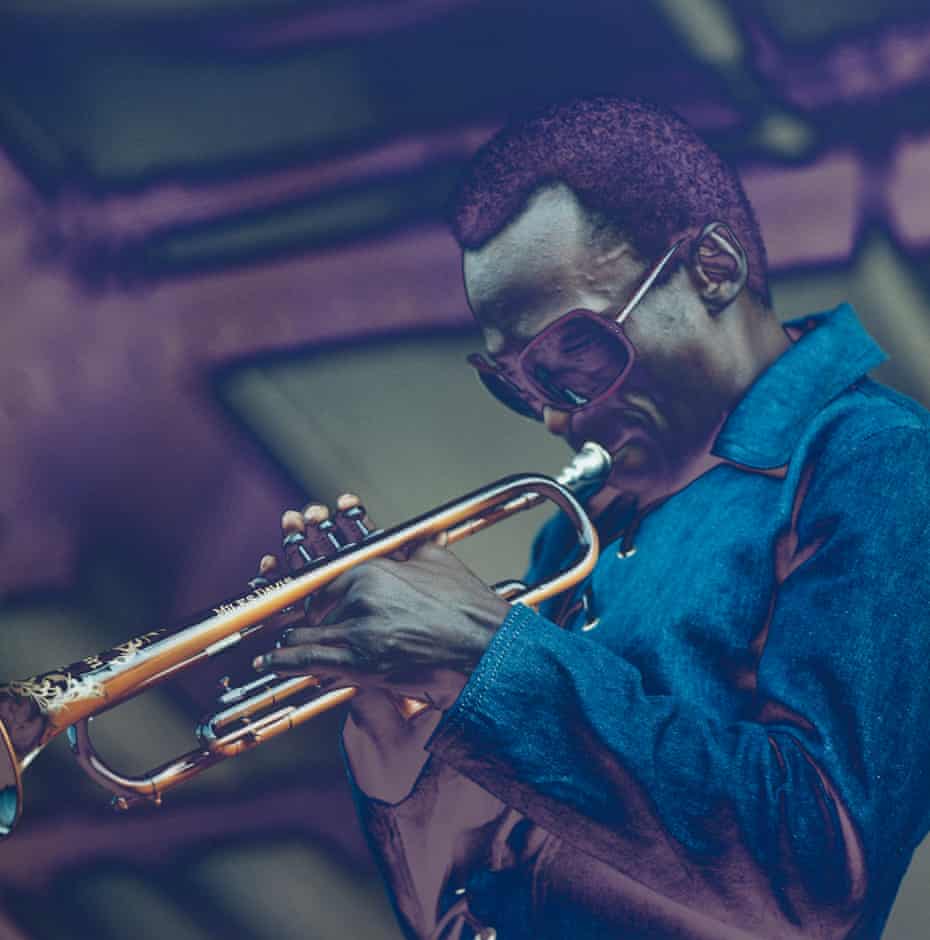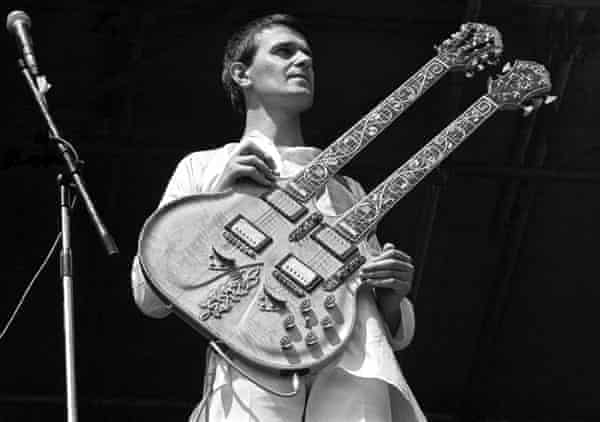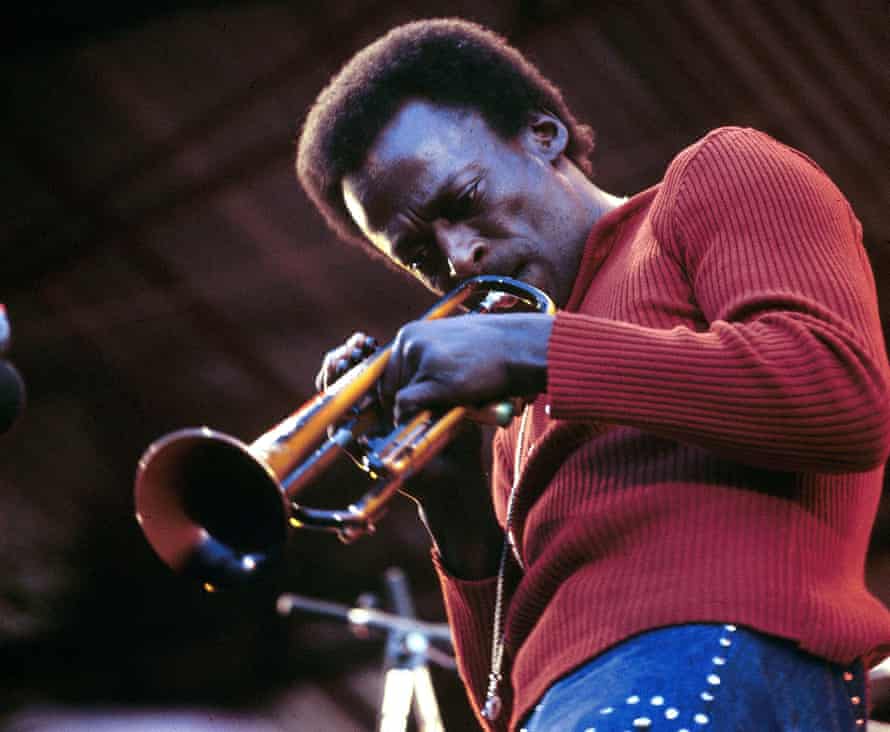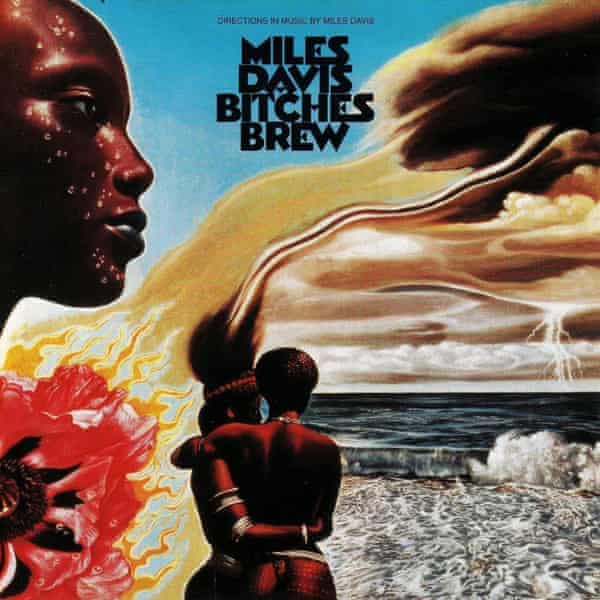'It sounded like the future': behind Miles Davis's greatest album
On the 50th anniversary of Bitches Brew, one of the contributing musicians and the director of a new documentary share their thoughts on the record

Guitarist John McLaughlin, who helped electrify Miles Davis’s music, describes Bitches Brew as “Picasso in sound”. Stanley Nelson, who directed a new documentary on Davis, calls it “an all-out assault”, while Davis’s official biographer, Quincy Troupe, labels it “a cultural breakthrough: it sounded like the future”.
Fifty years on, it still does. Next month will mark the 50th anniversary of Bitches Brew, a pivotal album that altered the trajectory of jazz, messed with the boundaries of funk, and pushed psychedelic rock to new heights of exploration. A double set released in March 1970, Bitches greatly advanced a pattern of progression in Davis’s music that snaked back to the start of his recording career in the 1950s. The full arc of Davis’s sound, and life, forms the basis of Birth of the Cool, a two-hour film created for the PBS series American Masters. (The film, which debuts on 25 February in the US, opens in the UK on 13 March and also spawned a new soundtrack on Legacy Records.) It covers everything from Davis’s ravenous creative development, to his ever-evolving fashion sense, to his complex relationship with women. But a key part of the drama centers on what led up to, and followed, the creative Vesuvius that was Bitches Brew.
McLaughlin found himself a central figure in that drama immediately after arriving in New York from his home in Europe at the start of 1969. “I was nervous as anything, with sweat running off me,” the guitarist recalled, with a laugh. “I’d only been in New York for 48 hours and I was with my hero!”
McLaughlin had come to America to join Lifetime, a new band led by Davis’s drummer, Tony Williams. But before he could start working with Williams, Davis snagged him, despite the fact that the trumpeter hadn’t heard McLaughlin’s just-recorded debut solo album, which planted the seeds for what would become the fusion movement. Davis seized on the young McLaughlin purely on the strength of Williams having hired him, as well as on his interest in using an electric guitar on the album he was starting to record, In a Silent Way. It was an album that would become nearly as legendary as Bitches. McLaughlin calls the Silent Way sessions a “baptism by fire”.

As soon as they started recording, Davis gave the young player cryptic instructions, such as “play like you don’t know how to play guitar”, McLaughlin recalled. “I just closed the score and started playing: no rhythm, no harmony, just playing the melody and casting my fate to the wind. He loved it.”
Silent Way – which also featured key players like Chick Corea, Herbie Hancock, Wayne Shorter and Joe Zawinul – represented Davis’s first all-electric album, following dalliances in that direction the year before on the Miles in the Sky and Filles de Kilimanjaro albums. Though a contemplative and inward work, Silent Way made a deep impression when it came out in July 1969, encouraging Davis to expand his electric forays exponentially with Bitches. McLaughlin’s guitar proved crucial to that expansion. “Miles took me under his wing,” the musician said. “I used to go over to his house on West 77th Street and he always wanted me to bring my guitar. I lost count of how many days I spent there, just hanging out. He would hit a couple of chords on the piano and say: ‘What do you hear? Do you hear a riff? A bass line?’ In England, I had earned my living playing rhythm and blues, funk and R&B-jazz. So, Miles picked my brain for anything he could relate to.”
Davis was curious, too, about the new sound of psychedelia. “He was asking me about Jimi [Hendrix],” McLaughlin said. “We had played together and I loved Jimi. Miles had never seen him. So, I took him to this art movie theater downtown to see the film Monterey Pop where Jimi ended by squirting lighter fluid on his guitar, setting it on fire. Miles was next to me saying: ‘Fuuck!’ He was enchanted.”
“Miles was being influenced by everything around him,” Troupe said. “He was trying to move his music forward.”

He was motivated, too, by the changing taste of the public. “1969 was the year jazz seemed to be withering on the vine,” Davis said in his official biography. “We played to a lot of half empty clubs. That told me something. I started realizing that most rock musicians didn’t know anything about music. I figured if they could sell all those records without knowing what they were really doing, I could too – only better.”
Just six months separated the sessions between Silent Way and Bitches. The latter took place over three days in August 1969, one week after Woodstock. Still, the two sessions seemed a world apart, given the dense cultural, aesthetic and political changes of the time. “That period was very volatile,” McLaughlin said. “The Vietnam war was happening, the whole black-white thing in America … Things were moving very quickly.”
When the musicians entered the studio to record Bitches, “it was clear that Miles wasn’t sure what he wanted”, McLaughlin recalled. “But he knew what he didn’t want. He didn’t want anything like what he had done before. He wanted it more rough and ready. We didn’t really have any scores, maybe just some chords he wrote down on a piece of paper from the bag he brought his coffee in. He’d set a tempo and we’d start. Every time we hit a groove, a really nice beat, he was happy and then he’d start playing. We just moved from one experiment to the next.”
Along the way, Davis would throw more inscrutable instructions at the musicians – which again, included Shorter, Zawinul and Corea, along with the bassist Dave Holland. “‘Play the space,’ he told me,” McLaughlin said, with a laugh. “What does that mean? It was like hearing a koan from a zen master.”
But it had a positive effect. “It obliged you to think differently,” he said. “You can get into musical habits the same way you get into daily habits. You have to beware of musical indolence. Miles was very much an overseer against musical indolence. He wanted blood and guts and heart all the time.”
The subsequent throw-it-at-the-wall approach resulted in sections that went nowhere, with parts that had to be thrown out. Consequently, the final album was a collage, assembled from various segments overseen by Davis and producer Teo Macero. “Miles loved Teo,” said Troupe. “But, in the end, it was his name that was going to be on it: he’s the creator of this.”
The musicians themselves were surprised by some of the final recording. “Sometimes in the studio, you don’t see the wood for the trees,” McLaughlin said. “But to hear the album, you hear it all.”
And there was a lot to hear. Everything about the music amplified Davis’s earlier approach. He featured more musicians that he had ever used before, often doubling, or tripling, the keyboardists and drummers. “He was opening up from his strict little quartets and quintets,” Troupe said. “He had access to a lot of different musicians and he could plug them in anytime he wanted to. And they were all young, energetic and different.”
The goal, Troupe said, was to create “a maelstrom of music. Everything swirling around him, going in different directions at once. And he was at the center, directing everything like a mad scientist.”
“It was Miles painting with music,” McLaughlin said, “and we were all his brushes.”
The result gave the music a quality at once unsettling and intriguing. In the long tracks – two of which occupy their own side – the musicians forever seem to be coalescing around something, moving towards a target without ever quite arriving. It’s the sound of perpetual discovery, without a final destination. “When you explore, you don’t know what you’re going to run into,” Troupe said. “It’s following your instincts. Music wasn’t a final resting place for Miles. It was a way forward.”
At the same time, the music left some of the audience, and certain critics, behind. “There’s a whole group of people who talk about Kind of Blue as the be all and end all,” Nelson said of that 1959, landmark release. “But Bitches Brew was something new. It appealed to a whole new bunch of fans.”

It helped that Clive Davis, the head of Miles Davis’s record company, Columbia, secured gigs for the band at the Fillmore East. There, on bills with the likes of Neil Young and the Steve Miller Band, Davis and his band wound up out-freaking the hippie freaks. While the trumpeter had taken inspiration from the energy of rock, the way it came out of his musicians bore no relation to the genre’s cliches. “We were looking for new forms of expression,” McLaughlin said.
The name given to the result was fusion, and though some albums that predate Bitches experimented with that approach, Bitches became the movement’s lodestar. The album’s provocative title and cover didn’t hurt. The surreal, Afro-futurist image that graced the gatefold cover, created by the German artist Mati Klarwein, played right into the sensibilities of stoned-out psychedelic rock fans. Inspired by that image, Carlos Santana used a different one by the same artist for his smash album Abraxis. Santana also began to play music inspired by Bitches, as did acts from the Allman Brothers to King Crimson to Soft Machine. At the same time, the key players from Bitches got such a boost from their contributions to the album – which, in McLaughlin’s case, included a track named after him – some formed their own bands, including Mahavishnu Orchestra (led by McLaughlin), Return to Forever (with Corea and Bitches drummer Lenny White) and Weather Report (featuring Shorter and Zawinul). Bitches became Davis’s fastest-selling album, moving 500,000 copies in its first year, and more than 1m units since. It also pointed the way to even harder music by the star, like Music from Jack Johnson, whose sonic violence presaged punk-jazz, and On the Corner, which went deeper into funk and also brought in Indian influences.
All of that experimentation was brewed on Bitches. “Ultimately, the album can be looked at in several ways,” said Nelson. “It launched a whole new way of thinking about jazz, and it was very influential with rock musicians. At the same time, it can be taken simply for the great sounds it contains.”
Birth of the Cool will show in the US on PBS on 25 February and will be released in the UK on 12 March

No comments:
Post a Comment